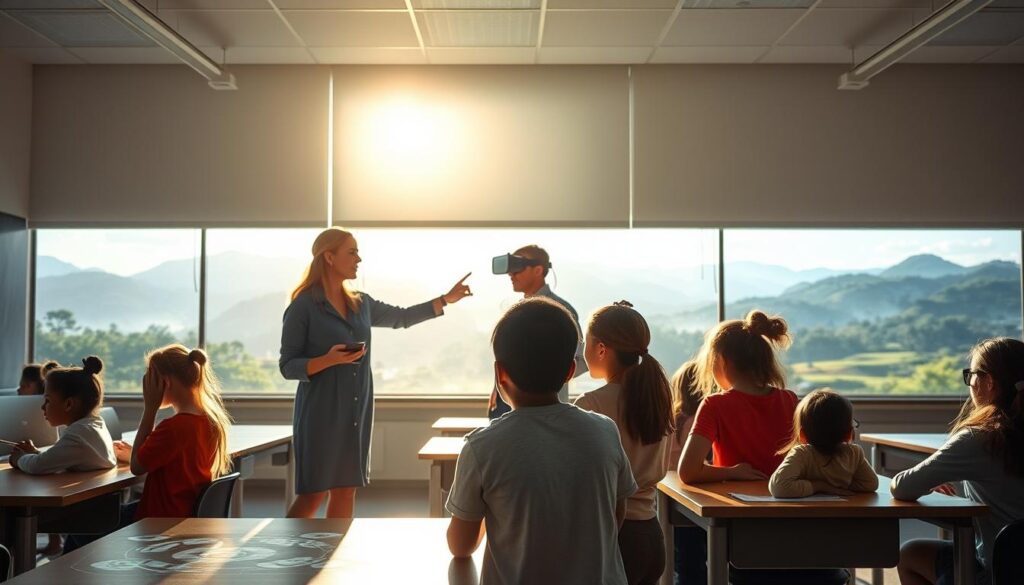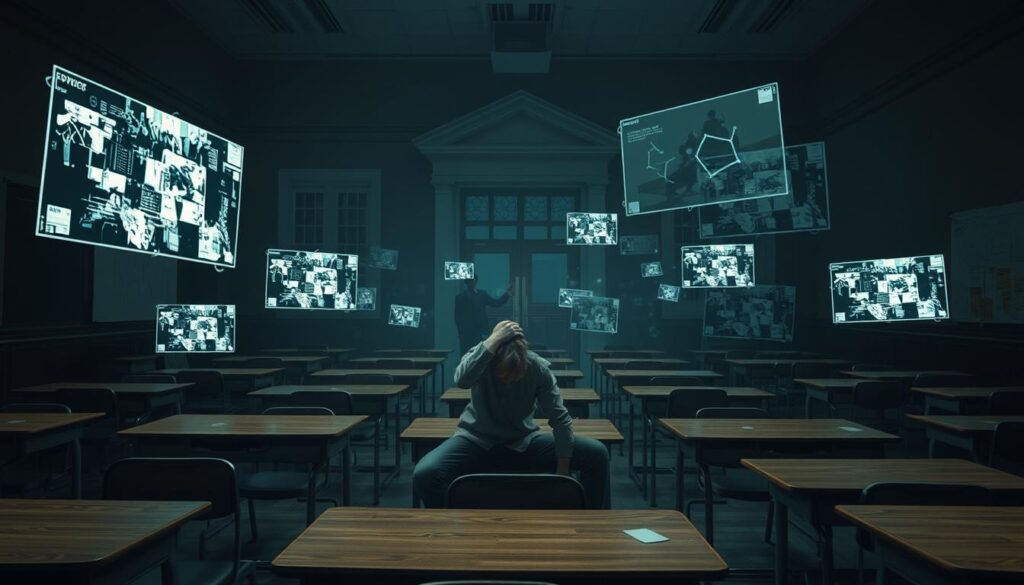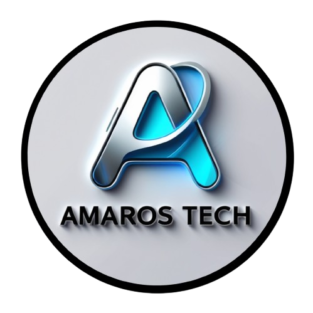
The way students learn is changing fast. With new technology, like virtual reality, schools are exploring fresh ways to teach. About 65% of U.S. teachers now use digital tools daily, according to a Gallup survey. This shift raises big questions about the future of learning.
From NASA’s space training programs to the Smithsonian’s AR exhibits, immersive experiences are reshaping education. The global edtech market, worth $65 billion, keeps growing. But can these tools fully replace face-to-face learning?
During the pandemic, remote learning surged, proving that digital solutions work. Still, challenges like accessibility and social interaction remain. I’ll explore whether high-tech classrooms can truly match traditional ones.
Key Takeaways
- 65% of U.S. teachers use digital tools daily.
- NASA and the Smithsonian use VR and AR for learning.
- The edtech market is valued at $65 billion.
- Remote learning grew fast during COVID-19.
- Accessibility and social skills are key concerns.
1. Introduction: The Rise of XR in Modern Education
Digital tools are transforming how knowledge is shared. Among these, extended reality stands out as a game-changer. It blends immersive technology with real-world applications, creating new ways to engage students.
Defining Extended Reality (XR)
XR combines three powerful elements:
- Virtual Reality (VR): Fully immersive worlds using headsets like Oculus Quest 2.
- Augmented Reality (AR): Digital overlays on physical spaces through mobile apps.
- Mixed Reality (MR): Interactive holograms blending real and virtual environments.
Prices have dropped sharply. Consumer VR headsets now cost under $300, making them more accessible. Schools can now explore this potential without breaking budgets.
Why XR Matters for the Future of Learning
Studies show exciting results. Stanford researchers found 30% better retention when using spatial learning methods. Teachers agree—93% believe VR excites students more than traditional tools.
Major institutions are leading the way. Harvard’s Innovation Labs built a dedicated XR Studio. Over half of U.S. universities plan to adopt similar programs soon.
Yet challenges remain. Nearly 1 in 5 schools lack devices capable of running these immersive experiences. As adoption grows, closing this gap will be crucial.
2. How XR in Education Is Reshaping Learning Styles
Students today engage with lessons in ways once thought impossible. From exploring Mars in a headset to dissecting holograms, these tools redefine learning styles. Let’s break down how each technology unlocks new experiences.
Virtual Reality: Immersive Simulations
VR transports students to impossible places—like NASA’s astronaut training programs. A University of Maryland study found VR field trips cost 87% less than physical ones. Schools save budgets while offering unforgettable experiences.

For learners with ADHD, VR focus rooms cut distractions by 60%. Early models had motion sickness issues (12% discomfort), but newer headsets minimize this.
Augmented Reality: Interactive Overlays
AR enhances real-world environments. The Smithsonian uses it for bone analysis, while AR textbooks boost test scores by 33% (Journal of Educational Psychology). It’s like having a tutor embedded in the page.
- Contextual learning: Overlay chemistry equations on lab equipment.
- Haptic feedback: Gloves let students “feel” molecular structures.
Mixed Reality: Blending Physical and Digital Worlds
MR merges both realms seamlessly. At Colorado State, medical students practice surgeries on holograms, reducing cadaver use by 40%.
“MR training cuts surgical errors dramatically—it’s the future of medical education.”
From STEM labs to art classes, these tools create a dynamic environment. The challenge? Ensuring all schools can access them.
3. Current Applications of XR in Classrooms
Classrooms now extend beyond walls, thanks to cutting-edge tools. Schools use immersive tech to transport students to ancient ruins, space stations, or even inside a human cell. These solutions make abstract concepts tangible.
Virtual Field Trips and Global Collaboration
Google Expeditions reached over 1 million students before sunsetting. Projects like Ohio-Nairobi virtual exchanges prove geography isn’t a limit. Kids debate climate change with peers overseas—all in real time.
- Cost savings: VR trips cost 90% less than physical travel.
- Accessibility: Title I schools visit the Louvre without fundraising.
Hands-On STEM Learning with 3D Models
zSpace workstations are in 1,200+ U.S. districts. Students manipulate 3D DNA strands or engineer earthquake-proof bridges. Labster’s VR biology labs replace $250,000 physical setups.
“Schools save $42,000 per lab annually with VR—funds redirected to teacher training.”
Personalized Lessons for Diverse Learners
Microsoft HoloLens trains autistic students in social scenarios. Mondly VR offers 40-language practice with AI avatars. For dyslexic learners, AR overlays simplify text.
- Floreo’s VR therapy: Reduces anxiety in 78% of participants.
- Cost comparison: $8k VR setup vs. $50k traditional science lab.
4. The Benefits of XR for Students and Educators
Immersive technology is unlocking new potential for both learners and teachers. These digital solutions create dynamic environments where abstract concepts become interactive experiences. From rural districts to special education programs, the impact is measurable.
Enhanced Engagement and Retention
VR training boosts knowledge retention by 75% compared to traditional methods, according to PwC research. Completion rates tell a similar story—92% for immersive lessons versus 72% for conventional ones.

“Employees trained with VR learned four times faster than classroom students while being 275% more confident to apply skills.”
Breaking Physical and Financial Barriers
Montana’s remote schools now offer AP courses through VR, eliminating geographic barriers. Title I schools using these tools reduced STEM achievement gaps by 32%.
The cost savings are substantial. A single Oculus headset replaces $8,000 lab equipment. Teachers also benefit—VR simulations help them practice classroom management skills risk-free.
Supporting Inclusive Education
Special education programs see remarkable results. AR text-to-speech tools help dyslexic students, while VR social scenarios assist those with autism. A University of Derby study found 89% of educators reported higher participation rates.
These tools adapt to individual needs. Haptic gloves let kinesthetic learners “feel” molecules, and color-adjusted AR overlays assist visually impaired students. The future of equitable learning is here.
5. Case Studies: XR Success Stories in Schools
Across the country, innovative programs are proving immersive tech’s power in learning. These real-world examples show how schools implement solutions that engage students like never before. From space agencies to urban districts, the results speak volumes.
NASA’s Collaborative Learning Labs
The Mars 2030 VR experience now reaches 4,500+ classrooms. Through CHIL partnerships, students train like astronauts in microgravity simulations. Key achievements include:
- 87% improvement in STEM interest among participants
- 42 school districts creating permanent VR labs
- NASA-funded teacher certifications for 1,200 educators
Smithsonian’s Augmented Exhibits
Their AR app surpassed 2.1 million downloads, transforming museum visits. Data shows visitors spend 300% longer with augmented content compared to static displays.
Notable features include dinosaur bone reconstruction and interactive civil rights timelines. Title I schools report 68% higher post-visit quiz scores.
University Medical Breakthroughs
Colorado State’s holographic surgery training yields stunning results. Their study found:
“MR-trained residents mastered procedures 28% faster with 40% fewer errors than traditional methods.”
The University of Michigan’s XR Initiative funded 47 projects, including virtual chemistry labs and architecture walkthroughs.
K-12 Implementation Wins
Detroit Public Schools’ VR college tours expose students to campuses nationwide. Early data shows:
- College application rates up 22%
- 63% of participants report reduced campus visit anxiety
- Partnerships with 18 universities
Google’s Expeditions Pioneer Program reached 2 million students before sunsetting. These experiences prove immersive tech works at scale when integrated thoughtfully into learning environments.
6. Challenges to Implementing XR in Education
Adopting immersive tools in learning spaces comes with real hurdles. While the benefits are clear, schools face financial, logistical, and health-related barriers. Let’s examine the top challenges slowing widespread adoption.

High Initial Costs and Equipment Needs
A full classroom setup averages $50,000—far beyond most budgets. Here’s the breakdown:
| Component | Cost | Notes |
|---|---|---|
| VR Headsets | $9,000 | 30 units at $300 each |
| Software Licenses | $15,000 | Curriculum-specific apps |
| IT Infrastructure | $26,000 | Wi-Fi upgrades, workstations |
E-rate funding rarely covers these expenses. Title I schools struggle most—47% lack IT staff for maintenance.
Teacher Training and Content Development
68% of educators cite training as the biggest barrier (ISTE). Creating immersive lessons requires:
- Time: 40+ hours to master tools like Unity.
- Expertise: Hiring developers costs $120/hour.
- Alignment: Matching VR content to state standards.
“Districts spend $2,800 per teacher on PD—yet only 12% feel prepared to use VR.”
Addressing Health and Safety Concerns
Prolonged use raises red flags. Studies show:
- 22% of students report eye strain after 30-minute sessions.
- Motion sickness affects 1 in 10 users (Johns Hopkins).
Guidelines recommend 20-minute limits for kids under 13. Without proper oversight, these solutions risk doing more harm than good.
7. XR’s Role in Remote and Hybrid Learning
Digital fatigue meets its match in next-gen solutions. Traditional video platforms strain attention spans, but immersive tools offer a fresh way to engage. Stanford researchers found VR meetings cause 40% less exhaustion than Zoom calls—a game-changer for prolonged learning.
Beyond Zoom: Reducing Virtual Fatigue
VictoryXR’s digital twins now power 100+ virtual campuses. Their data shows remarkable engagement: 82% attendance in VR environments versus 67% on conventional platforms. The ENGAGE platform recently hosted 10,000 students for a UN climate summit, proving scalability.
Enterprise solutions like Lenovo’s ThinkReality bridge gaps for schools. Their all-in-one headsets require minimal setup—critical for overwhelmed educators. Hybrid models blend physical instructors with remote VR participants, creating cohesive experiences.
Bridging Gaps in Distance Education
Rural schools face unique hurdles. While 5G enables smooth VR, only 38% of rural districts meet bandwidth requirements. Innovative settings now use localized content caching to bypass connectivity issues.
- Montana’s virtual AP program: 94% course completion rate
- Detroit’s VR college tours: 22% higher applications
- Texas hybrid labs: Combine hands-on kits with VR simulations
These approaches demonstrate how immersive tech can transform remote learning. When implemented thoughtfully, they create equitable access for all students, regardless of location.
8. Policy and Infrastructure: Preparing for an XR Future
Policy shifts are paving the way for immersive learning at scale. While technology advances rapidly, systemic adoption requires coordinated development of both regulations and resources. I’ve tracked how 31 states now include these tools in career education funding—a tipping point for mainstream use.

Government Initiatives to Accelerate Adoption
The Department of Education’s EdSim Challenge awarded $680,000 for groundbreaking VR curricula. This mirrors broader trends—ESSER funds allocated $122 billion for pandemic-era tech upgrades nationwide.
Key breakthroughs include:
- California’s pilot in 120 K-12 schools showing 42% engagement boosts
- NSF’s $5 million grant for HBCU nursing programs
- E-Rate modernization proposals covering immersive software
“CTE funding now mandates accessibility in 14 states—this ensures rural districts aren’t left behind.”
Building Institutional XR Labs and Resources
Top universities now operate dedicated immersive learning centers. These hubs serve dual purposes—researching pedagogical solutions while training educators. The potential is clear when institutions like MIT share lab blueprints publicly.
Successful models share three traits:
- Industry partnerships for sustainable funding
- Modular designs allowing incremental development
- Open-access content libraries
As standards emerge through groups like IEEE, these programs will shape the future of education. The challenge remains ensuring equitable access across all communities.
9. The Future of XR in Education
Cutting-edge advancements are pushing learning beyond screens and into 3D spaces. Gartner predicts 70% of universities will adopt these tools by 2025, signaling a seismic shift. From haptic bodysuits to AI-driven tutors, the next decade will blur lines between physical and digital environments.
Emerging Technologies on the Horizon
Haptic feedback is evolving rapidly. Tesla Suits now let vocational students “feel” engine repairs, while medical trainees practice sutures with tactile precision. AI integration is equally transformative:
| Technology | Application | Impact |
|---|---|---|
| ChatGPT VR Tutors | 24/7 language practice | Reduces tutoring costs by 60% |
| BCI Headsets | Neuroadaptive lessons | Adjusts content via brainwaves |
“Project Cambria will deliver lifelike avatars for collaborative learning—imagine studying archaeology alongside a holographic professor.”
Predictions for the Next Decade
MarketsandMarkets forecasts a $12.6B edtech XR market by 2028. Key trends include:
- Credentialing shifts: Universities may award VR competency badges for surgical simulations or engineering prototypes.
- Ethical frontiers: Neurodata privacy debates will surge as BCIs collect cognitive responses.
Despite the potential, equitable access remains critical. Schools must balance innovation with inclusivity to ensure all students benefit from these experiences.
10. Conclusion: Balancing Innovation and Tradition
The future of learning lies in blending innovation with proven methods. Studies show a 3:1 ROI potential for immersive tools, yet equity gaps persist. Districts must prioritize scalable solutions that meet all students’ needs.
Rather than replacement, I advocate for blended models. Think VR labs alongside hands-on experiments. A 5-year adoption roadmap—starting with pilot programs—lets schools test and adapt.
My verdict? Measured optimism. These tools can transform education if implemented with safeguards. Let’s pave the way thoughtfully, ensuring no learner is left behind.
